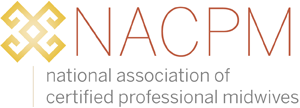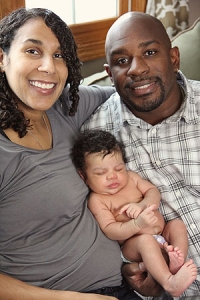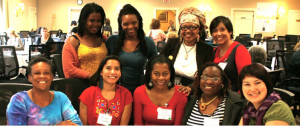Midwives take race, justice, inequities head on
February 14, 2017
 by John Weeks, Publisher/Editor of The Integrator Blog News and Reports Issues of class, economics, opportunity, and race have tainted the integrative health and medicine era since the Eisenberg survey kicked off the dialogue in 1993. That study found that users of “unconventional medicine” tended to be white, better-off, and higher educated. Yet, of all the natural health, complementary and integrative professions, just one has highlighted social justice as core to its mission: the home birth-oriented midwives led by the National Association of Certified Professional Midwives (NACPM).
by John Weeks, Publisher/Editor of The Integrator Blog News and Reports Issues of class, economics, opportunity, and race have tainted the integrative health and medicine era since the Eisenberg survey kicked off the dialogue in 1993. That study found that users of “unconventional medicine” tended to be white, better-off, and higher educated. Yet, of all the natural health, complementary and integrative professions, just one has highlighted social justice as core to its mission: the home birth-oriented midwives led by the National Association of Certified Professional Midwives (NACPM).  The distinction has been apparent in recent months as NACPM has rolled out a webinar series entitled Equity, Race and Access to Midwifery. One speaker, pediatrician Nancy Anderson, MD, MPH, pictured, will share outcomes of a research project sponsored by NACPM. The project’s goal was to“understand the barriers that women of color experience with respect to the midwifery profession, and to describe the optimal structure for a midwifery education scholarship program aimed at women of color.” This followed a two-part series, available to the public, on “Social and Physiologic Impact of Racism in Maternal-Child Health” are available on the site for viewing. One features an associate administrator for the Health Resources and Services Administration. A quick glance at the NACPM’s website makes clear that the organization’s engagement with these issues is neither temporal nor short-lived. Of four themes on the landing page, one is “Addressing Social Justice and Birth. The Board of Directors has a special working group, the charge for which begins, “NACPM recognizes the pervasive and destructive impact of racism within our culture and within the midwifery community and is committed to confronting it on both an individual level and within our board and organization.”
The distinction has been apparent in recent months as NACPM has rolled out a webinar series entitled Equity, Race and Access to Midwifery. One speaker, pediatrician Nancy Anderson, MD, MPH, pictured, will share outcomes of a research project sponsored by NACPM. The project’s goal was to“understand the barriers that women of color experience with respect to the midwifery profession, and to describe the optimal structure for a midwifery education scholarship program aimed at women of color.” This followed a two-part series, available to the public, on “Social and Physiologic Impact of Racism in Maternal-Child Health” are available on the site for viewing. One features an associate administrator for the Health Resources and Services Administration. A quick glance at the NACPM’s website makes clear that the organization’s engagement with these issues is neither temporal nor short-lived. Of four themes on the landing page, one is “Addressing Social Justice and Birth. The Board of Directors has a special working group, the charge for which begins, “NACPM recognizes the pervasive and destructive impact of racism within our culture and within the midwifery community and is committed to confronting it on both an individual level and within our board and organization.”  The deep work on the topic dates back five years. The NACPM site “acknowledge(s) and appreciate(s) the work of the Anti-Racism and Anti-Oppression Work in Midwifery group that emerged from the CPM Symposium 2012.” They share anti-racism resources developed since that conference through a leading state affiliate, the Midwives Association of Washington. NACPM’s commitment includes publication of their “strategic intention to address racism and racial disparities in US maternity care.” The initiative is remarkably prioritized by NACPM. It is listed side by side with typical core initiatives of emerging professions: federal legislative efforts, state licensing, and standards of practice. Add to these themes race and equity. The work is a living focus.“We encourage NACPM members to participate and access the anti-racism training resources this group (Anti-Racist and Anti-Oppression Midwives -AROM) provides. Comment: First, a brief personal story about how one’s vision can be narrow indeed. In 1990, I was responsible for choosing dates for the conference of the American Association of Naturopathic Physicians. For failure to open my own myopic view, I placed the conference on the Jewish holiday of Rosh Hashanah. Many valuable members were none too happy. Many couldn’t attend. It didn’t help that I forgot the next year and did it again. Picture my karma swirling against a porcelain backdrop.
The deep work on the topic dates back five years. The NACPM site “acknowledge(s) and appreciate(s) the work of the Anti-Racism and Anti-Oppression Work in Midwifery group that emerged from the CPM Symposium 2012.” They share anti-racism resources developed since that conference through a leading state affiliate, the Midwives Association of Washington. NACPM’s commitment includes publication of their “strategic intention to address racism and racial disparities in US maternity care.” The initiative is remarkably prioritized by NACPM. It is listed side by side with typical core initiatives of emerging professions: federal legislative efforts, state licensing, and standards of practice. Add to these themes race and equity. The work is a living focus.“We encourage NACPM members to participate and access the anti-racism training resources this group (Anti-Racist and Anti-Oppression Midwives -AROM) provides. Comment: First, a brief personal story about how one’s vision can be narrow indeed. In 1990, I was responsible for choosing dates for the conference of the American Association of Naturopathic Physicians. For failure to open my own myopic view, I placed the conference on the Jewish holiday of Rosh Hashanah. Many valuable members were none too happy. Many couldn’t attend. It didn’t help that I forgot the next year and did it again. Picture my karma swirling against a porcelain backdrop.  I recall this because a more egregious oversight kicked off NACPM’s high commitment to addressing race, culture, and economics. The event was the CPM Symposium 2012, some attendees of which are pictured. I was invited to provide a plenary talk on interprofessionalism. The setting was a gorgeous retreat center not far from the U.S. Capitol. What the planners did not consider was that the location, apparently serene as it seemed, was formerly a plantation owned by slave-holders and built and worked by slaves. The ground, the trees, the “gorgeous” buildings, and out-buildings were all impregnated with that past. The midwives of color in attendance rebelled. To their credit, the organizers dropped large segments of planned content to focus on the issues that arose from the ground on, which we all walked, from the buildings in which we were all housed. Clearly the NACPM has not stopped since. Which brings me to a recent conversation with a federal leader in research in integrative medicine. I’d referenced research coming out of the clinics at the academic health centers with integrative medicine clinics. These were brushed away by the policy-setter with a challenge. "What can be generalized to the whole population from that set of upper income, well-educated, mainly white, mainly female population?" Isn’t this akin to the research practice of the 1950s-1960s that judged all human behavior based on findings among adult, white, American males in the heavy drinking, heavy smoking, Mad Men era? The ability to get grants is being restricted by the limited population served. Terrific efforts in integrative medicine like Integrative Medicine for the Underserved (IM4US) are seeking to bridge the cultural, racial and income divides. The initiative from Myles Spar, MD, MPH, Integrative Medicine Access, is also seeking to address the gap through a distinctive campaign that asks integrative practitioners to commit to donate a portion of care to the underserved on a regular basis. These programs noted, none of the professional or academic organizations for the other complementary and integrative professions—of which I am aware—has chosen to bridge the field’s culture and race gap with the kind of commitment NACPM has shown. Perhaps it’s time for NACPM to offer a seminar—maybe through the Academic Collaborative for Integrative Health and its midwifery organizational members or the Integrative Health Policy Consortium in which NACPM is a Partner for Health—to help guide other professions to more proactivity in this area. It furthers one to cross the great water.
I recall this because a more egregious oversight kicked off NACPM’s high commitment to addressing race, culture, and economics. The event was the CPM Symposium 2012, some attendees of which are pictured. I was invited to provide a plenary talk on interprofessionalism. The setting was a gorgeous retreat center not far from the U.S. Capitol. What the planners did not consider was that the location, apparently serene as it seemed, was formerly a plantation owned by slave-holders and built and worked by slaves. The ground, the trees, the “gorgeous” buildings, and out-buildings were all impregnated with that past. The midwives of color in attendance rebelled. To their credit, the organizers dropped large segments of planned content to focus on the issues that arose from the ground on, which we all walked, from the buildings in which we were all housed. Clearly the NACPM has not stopped since. Which brings me to a recent conversation with a federal leader in research in integrative medicine. I’d referenced research coming out of the clinics at the academic health centers with integrative medicine clinics. These were brushed away by the policy-setter with a challenge. "What can be generalized to the whole population from that set of upper income, well-educated, mainly white, mainly female population?" Isn’t this akin to the research practice of the 1950s-1960s that judged all human behavior based on findings among adult, white, American males in the heavy drinking, heavy smoking, Mad Men era? The ability to get grants is being restricted by the limited population served. Terrific efforts in integrative medicine like Integrative Medicine for the Underserved (IM4US) are seeking to bridge the cultural, racial and income divides. The initiative from Myles Spar, MD, MPH, Integrative Medicine Access, is also seeking to address the gap through a distinctive campaign that asks integrative practitioners to commit to donate a portion of care to the underserved on a regular basis. These programs noted, none of the professional or academic organizations for the other complementary and integrative professions—of which I am aware—has chosen to bridge the field’s culture and race gap with the kind of commitment NACPM has shown. Perhaps it’s time for NACPM to offer a seminar—maybe through the Academic Collaborative for Integrative Health and its midwifery organizational members or the Integrative Health Policy Consortium in which NACPM is a Partner for Health—to help guide other professions to more proactivity in this area. It furthers one to cross the great water.



















SHARE